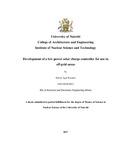| dc.description.abstract | Most handheld devices used for field measurements are run on batteries which are charged from the grid. However, batteries have limited run-time and therefore have to be charged periodically in order to extend their operation. Consequently, using battery-powered devices in off-grid areas is inconvenient. It is therefore imperative to find an alternative source of electricity to charge these devices while being used in off-grid areas. This study develops a prototype of a solar charge controller that is capable of sustaining the operation of Nickel Metal Hydride and Lithium-ion battery-powered devices in off-grid areas. The charge controller consists of a Fuzzy-based Perturb and Observe algorithm which optimizes the extraction of power from a solar panel, and a Buck converter which regulates charging voltage and current over a wide range of values.
A MATLAB model of a solar power system was used to develop and tune the Fuzzy-based Perturb and Observe algorithm. Thereafter, a prototype of a solar charge controller was built using PIC32MX170F256B microcontroller and a Buck converter. A program which consisted of the Fuzzy-based Perturb and Observe algorithm and the charge control algorithms for Nickel Metal Hydride and Lithium ion batteries was written in C language, compiled using MPLABX-IDE software and loaded into the microcontroller using PICKit 3 programmer. Several tests were done on the prototype under artificial and natural light to determine the functionality of the solar charge controller.
From the experimental results, it was observed that the prototype increased the power extracted from a solar panel by 71% when compared to a solar power system with no Maximum Power Point tracking algorithm. Moreover, it improved the tracking speed by 93%, and reduced the power fluctuations by 76 % when compared to the conventional Perturb and Observe algorithm with small and large perturbation steps, respectively. The result of charging batteries using the prototype solar charge controller showed that it was able to regulate charging current and voltage, and accurately detect the full charge. | en_US |



